#and learns about AI sets for note taking software
Explore tagged Tumblr posts
Text
"We have clinical people that make sure our data set isn't biased and doesn’t go off the rails"
My immediate thought: “Ah, I don't have to worry about omegaverae showing up in my therapy note, that’s great news.”
0 notes
Text
Some more tsams/eaps headcanons because I’m bored in class
To expand on the AI chip thing mentioned previously: Ai chips come with a base, company-appointed personality and traits. Most Suns start off loud and naïve. Most Moons start off too curious for their own good. Suns fidget with their rays. Moons prefer auditory stimulation. Etc. It’s only when that base personality/programming is subject to an environment that teaches the base personality something—Our Sun learned to put up with things he didn’t like for a time, Old Moon learned that force kept Sun in the little box he needed Sun to be in to feel in control—that new information is stored into the chip. Eclipses do not have a set personality and are generally a hodgepodge of both depending on how they came to be. (For example, Eclipse and Solar have just enough Moon base personality in them to set them apart from Sun, but both are mostly Sun base programming. Ruin is a careful mix of both Sun and Moon programming because they were able to manually edit that, which resulted in a personality reset when they fully merged. (Lunar is a special case, Eclipse shoved most of his remaining Sun base personality off to Lunar, but because Eclipse is a mix of both, that code was inseparable from some Moon base personality.) When a personality has developed enough, removing certain parts of the base personality can affect the function of that part of the developed personality, for example, if Lunar were to delete some of his Sun base programming, he would find that experiencing things that stem from that programming disorienting, because the foundation that allowed the proper response to that stimuli is gone. In small bits, it’s possible to remove base traits like preferences, or entire personality traits so long as it’s done early in that AI’s development. There are workarounds to this. Dark Sun knows a lot of those workarounds, but that doesn’t mean he uses them often.
On material objects, Star power can act like radium with a shorter halflife. The same goes for negative star power. Visiting dimensions with high levels of either can result in contamination, such as Ruin’s dimension in the time it was accessible or Dark Sun’s pocket dimension without proper protections. Contamination is a residue of the power that fades over time if it is not removed. If certain components are contaminated, like processors or joints, their performance can be affected. [Note I’m not the most familiar with TSAMS’ established magic rules or most things about star power, I just have a general idea of it and this makes the most sense to me.] Also note I said material objects, this does not extend to software, where it acts differently.
It is possible to detect levels of Star power in dimensions with technology coveted by Dark Sun, Nexus, and Ruin, all for different reasons. By analyzing spikes or sudden drops in levels of a dimension, it’s possible to guesstimate where a dimension hopper with high levels of either power ended up. If Nexus were to drop into another dimension, Dark sun could figure out which one based on recent trends in Star power levels across the dimensions in his scope, in Nexus’ case the levels would drop because the negative Star power isn’t 100% negated by the present positive Star power. The closer the levels of Star power are to each other, the more stable the trends are, because they tend to cancel each other out. Think of a seismograph and detecting earthquakes, with the constant levels being the equal amounts of negative and positive power. The balance of these energies fluctuate in natural cycles. The Astrals are part of these cycles.
Take anything I say about the magic thing with a massive grain of salt, the most I know is the concept of magic pools and general applications of magic per individual users, and there might’ve been something involving golden Freddy idk. I like to imagine magic as metaphorical hula hoops. Everyone’s hula hoop is a little bit different in color, size, features etc, but the user must know how to use the hula hoop to be able to use their magic. Learning different ways to use the hula hoops is the equivalent of expanding what the user’s magic is capable of (Transmutation, teleportation, and summoning things are all different capabilities that can be learned, for example. Some are considered more complex than others.) in my head ruin’s hula hoop lights up with activity lol. Sun’s hula hoop makes groan tube noises. Being able to do different things/multitasking while using the metaphorical hula hoop is something that can be learned by users with more experience. Ruin is one of these users. Eclipse is also able to do this, but tends to combine it with technology. (Continued in a reblog)
#quirky headcanons#this is all speculation and what makes sense to me. filling in the gaps of my knowledge with educated guessing#tsams#eaps
24 notes
·
View notes
Text
Writing Tips for Beginners
Writing can feel intimidating when you're just starting out. There’s a lot to consider, but taking things step by step can make the process much smoother. This guide walks you through essential tips to help you navigate your writing journey with confidence.
1. Why Do You Want to Write?
The first step in becoming a writer is understanding your motivation. Ask yourself:
- Do you want to write entertaining stories with no deeper lessons?
- Are you passionate about highlighting important issues to educate readers?
- Do you wish to share valuable life lessons and inspire others?
- Or is it a mix of all these reasons?
Defining your “why” will shape what and how you write, giving your work purpose and direction.
2. Choosing a Writing Style
Your writing style is a key part of storytelling. Start by exploring:
- Third Person: "Jake went to school late this morning because he forgot to set his alarm clock."
- First Person: "I can't believe I forgot to set my alarm clock last night. Now, I'm late for school."
Both styles are powerful, but picking one to focus on as a beginner can help you find your groove. Mastery of both can come later.
3. Choosing a Genre
Think about what you love to read or watch—those genres can inspire your writing. Your familiarity with the genre will guide you in crafting your story, but always ensure your ideas are original. Copying someone else’s work risks losing the respect and trust of your audience.
4. Brainstorming Ideas
Brainstorming is where creativity starts. Keep a notebook or document of ideas—no matter how wild they seem. Even ideas that don’t fit one story might inspire another in the future.
5. Creating a Writing Schedule
Life can be busy, but carving out time for writing is essential. Even five minutes a day can build momentum and keep creativity flowing. Little by little, it all adds up.
6. Making a Plot Outline
Outlining your plot keeps your story organized and prevents excessive rewrites. A simple outline looks like this:
- Jane goes to the library.
- Jane grabs her favorite book.
- Jane meets the librarian.
This allows for creativity while keeping the story on track.
7. Creating Character Sheets
Characters are the heart of your story. Use character sheets to note their:
- Features
- Personality
- Behaviors
- Interests
This ensures your characters are unique and memorable, reducing confusion for readers.
8. Choosing Writing Software
Pick software that suits your needs. Options include:
- Microsoft Word: Reliable and feature-rich for writing, editing, and formatting.
- Google Docs: Free and convenient, but dependent on internet access.
- Open-Source Software: Free alternatives, though they may have limited features.
9. Writing Tools
Leverage tools like Grammarly to catch errors and refine your work. While AI tools can aid editing and polishing, remember they're there to support—not replace—your creativity. Work smarter, not harder!
10. Editing
Editing doesn’t have to be daunting. Take breaks to see your work with fresh eyes and use tools like Grammarly or text-to-speech programs to catch errors. Rewrite or cut scenes that don’t serve the story’s purpose.
11. Exploring Publishing Options
You have two main routes:
- Traditional Publishing: Requires pitching your manuscript but offers professional backing—though it can take time.
- Self-Publishing: Faster and gives you full control. Platforms like Kindle Direct Publishing (KDP) offer free marketing tools like giveaways and discounts.
Research to find what fits your goals.
Conclusion
Writing takes time, patience, and a willingness to learn. By following these tips, you’ll be well on your way to starting and succeeding on your writing journey. Happy writing!
#writing community#creative writing#writing tips#writingjourney#writers of tumblr#new writers on tumblr#storytelling#tipsforbeginners#writing skills#fiction writing
25 notes
·
View notes
Note
What are “current” androids like in XYZoul, out of curiosity? I noticed that Carmichael was a bit out of date around the time the story starts, so I wonder what newer models are like. Are there any aesthetic differences, things of that sort?
(Totally not rotating the idea of my own robobutler in this setting, if that’s okay of course)
fun question! I'm using them as a device to comment on where I feel modern tech is going, so the "rapid evolution of the tech" early adoption period is over in present canon. base system capabilities are still similar as they were from years back. the AI they come equipped with still learns things at similar paces, still has similar conversational functionality, etc, but since this is also satire, the newer ones also have more bloatware, harder to hack walled garden-style OSes, subscription-based update cycles, harder to open/repair, or internet-connected spying features no one asked for. LMAO
other improvements would be more or less what you expect from the endless forward march of technology, like faster connection speed, more storage, wider customization options, more fluid/realistic movements and responses to terrain, larger batteries and more convenient ways to charge them, etc.
the notable thing for Carmichael specifically is that he still has a mostly "mechanical"-looking body with joints and such. the only places with synthetic skin are his neck/face, hence why he's fully clothed. it was a cost-cutting measure in-universe, so that sort of tech is more feasible now.
I really like to think of "sentient robotic life" as being similar to computers, so that's the angle I take. so for Carmichael, he came from a small forward-thinking manufacturer that since went out of business, so he'd be like. the kind of computer you hear about 20 years after it was discontinued as like an Interesting Tech Oddity that's only really appreciated by Hobbyists nowadays. dshjkfhsdf
Carmichael's manufacturer had an emphasis on human form before it became more feasible in-universe, so at the time of purchase he was seen as fancy but also expensive, form over function, a bit costly in comparison to what you got features-wise but Ivanna wanted a funny little butler bot SO HEY! in that sense she got everything she wanted.
note about "butler bot"--manufacturers also vary on what purposes they create their androids for. some of them are generalist/hobbyist focused but others come equipped with software and hardware for specific industries, usually service. Carmichael's function is "personal assistant" at the base, and he's technically more like a valet or a concierge, but yknow. it's the post-apocalypse 2100s no one knows what an early 1900s butler is like anymore nor do they care. it's all in the presentation.
aesthetics would be down to the manufacturer and the buyer's preferences--since they're a very expensive consumer product, most of them are customizable and built to order. if you just wanted an in-home robot helper, or a robot to help with industry automation, there are capital-R Robots for that, streamlined for those purposes and thus not human at all. androids don't get made for hard labor because it's a waste of resources; they're specifically to replace humans in human-facing jobs, or to be Rich People's Personal Assistants. customization is more or less the highlight, and I imagine the manufacturer's suite of available styles factors into a prospective buyer's decision. there are some that look fully human, but others still that play up a robot look deliberately, with no synthetic skin at all. please, imagine with me a gamer LEDs-style android. thank you.
as for your parenthetical, I certainly don't hold any copyright over the concept of androids, or butlers, or android butlers. if the character's design and story context are different beyond those two factors, then there are no toes stepped on 👍
3 notes
·
View notes
Text
College Tools Education
Master Time Management
One of the first steps toward increased productivity is effective time management. Renowned publications like Harvard Business Review emphasize that time management is more about big-picture strategic planning rather than just everyday life hacks. It starts with setting clear priorities and understanding the difference between urgent and important tasks.
Here's how to get started:
Begin each week by mapping out major assignments, exams, and other obligations.
Utilize digital calendars and task management tools to keep everything organized.
Avoid multitasking as it can reduce the quality of your work and lead to burnout.
Develop a Study Routine
Studying efficiently is paramount for students who aim to grasp complex economic models and business strategies. Customizing a study plan that fits your learning style can significantly increase your retention and understanding.
Try these tips:
Dedicate specific times of the day to study when you're least likely to be interrupted.
Break down study material into manageable sections to avoid overwhelm.
Use active learning techniques such as teaching concepts to a peer or creating your own exam questions.
Utilize Multiple Choice Question Solvers
For exams, particularly those involving multiple-choice questions, students can benefit from technological advancements such as AI-powered multiple choice questions solvers. These tools can provide practice quizzes and instant feedback, which is essential for mastering the material.
Consider these benefits:
Immediate results help to quickly identify areas where more review is needed.
They resemble real exam formats, aiding in practice under timed conditions.
Some solvers can even offer detailed explanations for answers, enhancing your learning curve.
Enhance Productivity with Tech Tools
In the age of remote learning and digital tools, harnessing technology is vital for staying ahead. Many apps and software are designed to help with note-taking, project management, and collaboration. Our very own College Tools has a range of features that seamlessly integrate with your workflow in any Learning Management System.
Focus on tools that:
Allow for efficient note-taking and information organization.
Enable project collaboration in real-time with peers or instructors.
Offer customization to tailor the functionalities according to your productivity needs.
Balance Work and Leisure
As much as productivity is about working efficiently, it's also about resting effectively. Business and economics students should not underestimate the power of proper rest and leisure activities in maintaining a healthy work-life balance.
Here's how you can achieve balance:
Schedule breaks and leisure activities just as you would academic tasks.
Engage in activities that are completely unrelated to your studies to give your mind a break.
Practice regular self-care routines to ensure you're mentally and physically well.
Strategies from Industry Leaders
Emulating the productivity tactics of successful business leaders can also be enlightening. Outlets such as Forbes detail various approaches taken by industry professionals which can be adapted to your student life.
Key takeaways include:
Strict prioritization to allocate your best hours to the most critical tasks.
Delegation skills, which in a student context, means seeking help when you're overwhelmed, perhaps in the form of a study group.
Continuous learning and improvement, as productivity is a skill that can always be developed further.
Effective Use of Breaks
According to Lifehack, short breaks can play a significant role in maintaining productivity over long study sessions. Students should take regular breaks to stay focused and rested.
To make the most of your breaks:
Step away from your study area to ensure a change of environment.
Use techniques such as the Pomodoro Technique to structure time periods of focused study and rest.
Engage in activities that are rejuvenating, whether it's a quick walk outside or a brief meditation session.
The journey to becoming highly productive is a personal one, and what works for one student may not be as effective for another. It's important to try different strategies, measure your progress, and tweak your approach accordingly. Whether it's streamlining your study habits or harnessing the potential of digital tools, every small step towards increased productivity paves the path for success in the dynamic fields of business and economics.
2 notes
·
View notes
Text
TL;DR: in this post, i wax on about the abandoned concept album/multimedia project Lifehouse by Pete Townshend/The Who in the context of algorithms and artworks
people on Twitter aren't understanding that this is an ad for a scifi novel. it sounds interesting, to a degree.
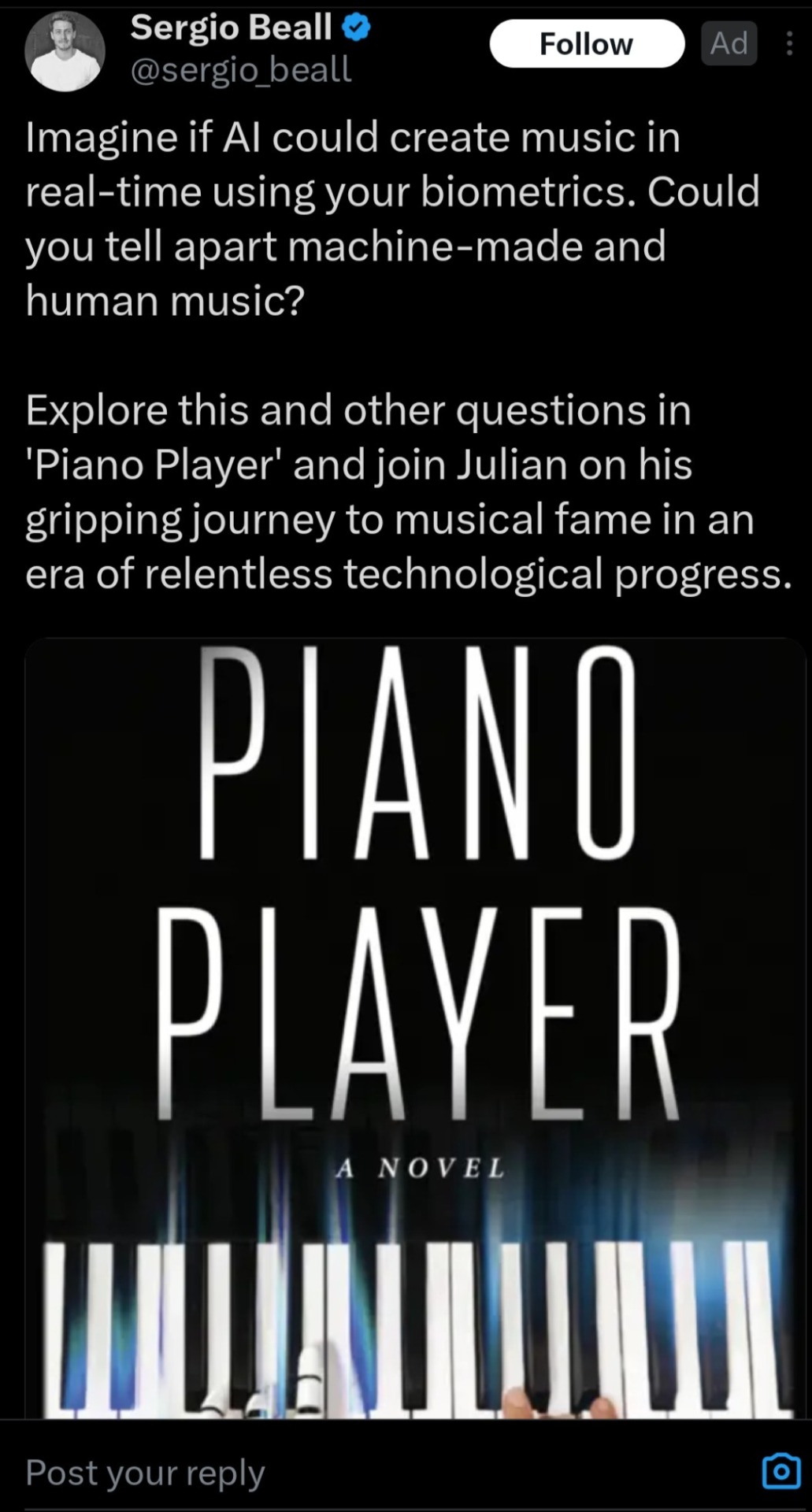
the first sentence reminds me of [The Who's] Pete Townshend's Lifehouse, still one of the most fascinating musical experiments i've ever read about.
i wish i knew about all that back when the Lifehouse Method website was a thing. for those unaware, it was a site created by Pete in conjunction with composer Lawrence Ball and software developer Dave Snowdon in which someone could input their personal data and generate "authentic musical 'portraits,'" pieces of music customized via algorithms that work based on whatever data you input. if you know anything about The Who, you'll probably recognize this as a facet of what would eventually become the album Who's Next, Lifehouse, a huge multimedia project involving a rock opera album, live performances with audience participation and complex tech on stage, a movie, who knows what else.
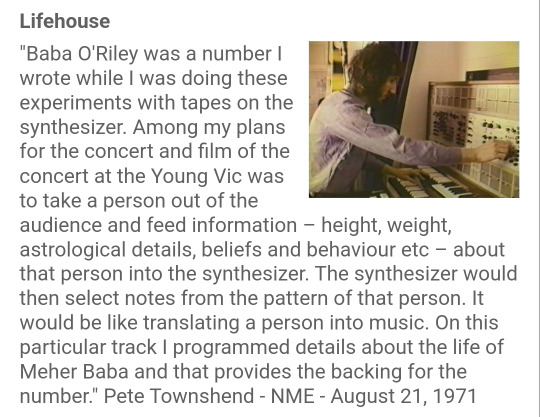
https://archive.is/8tYoM
i've always wished i could do one of these "musical portraits." i remember when I first heard about algorithmic (i refuse to call it AI because it isn't true AI) music generators, this was the first thing i thought of. back when they were in a rudimentary state, i played around with one for my own amusement (not for my own music, all that comes from my own head unfortunately for you), and while it was fascinating, it didn't go far enough in the direction i hoped. thinking of OpenAI's MuseNet, it takes a few notes worth of MIDI data & a style suggestion and then kinda randomly guesses what would be a good fit after those notes.
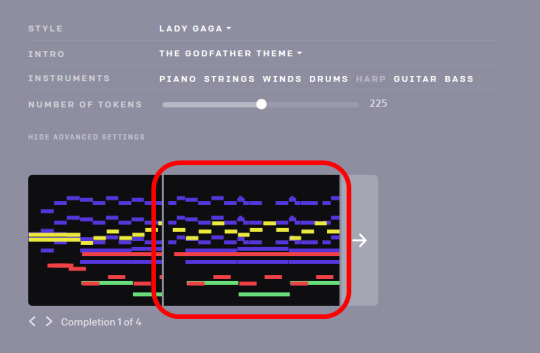
<image sourced from https://gigazine.net/gsc_news/en/20190426-muse-net>
and y'know, it makes for some fun meme videos:
youtube
youtube
youtube
<shoutout to the papaya>
but you can also see it only goes so far, and still requires musical input. it isn't quite on the level of being usable for much. and it really isn't quite the same. it's using inputted data, but not, say, biometric or biographical data. it's musical parameters that are being input as the data.
i really want to one day see a true realization of Lifehouse. one of my wildest goals is to be the one to do that. admittedly, i feel like in the current artistic climate the art world might no longer be ready for it; people would see it, instantly think "AI ART EW," and back away. but in this case, i don't feel like that's a fair assessment of what the concept is. the idea was to find each person's unique signature melody via these musical portraits. it isn't meant for anything really beyond personal identification, when it comes down to it. it fascinates me from a musical standpoint, and as a person who holds a psychology degree. imagine what someone can learn about oneself via this process! would your musical portrait be different at different points in your life? what could you tell about your personality from a single melody, or about your life history, or your beliefs and values? how would all of that reflect in your music? what genre is your soul? could a musical portrait truly capture any of that? with sufficiently advanced tech, sure, but idk if we're there yet.
heck imagine the therapeutic implications! imagine this tech being used in an art/music therapy setting, in which you work with a therapist to input your data, get a melody, and then use that melody with whatever form of musical expression you prefer (e.g. if you prefer to play the piano, guitar, a DAW, etc). what would you and your therapist be able to learn about you?
i truly do believe that, when it comes down to it, everyone has their own musical identification, "a song in their heart" if you will. i wish to expose people's hearts to get that music out, so that people may hopefully understand themselves better.
we might actually be at the level of tech necessary to truly realize a project like Lifehouse, but the tech isn't being used in this way. our current tech relies on predictive algorithms that kinda mostly draw on established musical forms, tradition, and there are only so many notes in the musical alphabet and only so many combinations and permutations thereof. a true realization of this tech would work, say, maybe in a similar way to how Pokémon speedrunners essentially break the game and essentially reprogram it to do what they want via a series of unexpected inputs. arbitrary code execution is what that's called, and i bet a similar function might help greatly in creating a uniquely generated musical portrait. because, when it comes down to it, are we not all Glitch Pokémon who cannot be contained by the boundaries of our programming?
youtube
anyway that was a long ramble. feel free to gimme feedback like you're a guitar held up to an amp or feedback like an echo chamber, whichever you prefer. this post idk if it'll make both pro & anti AI people mad or not, but that's what happens when your position on a thing is more complicated than a simple binary.
currently homeless still, so please help me if you can:
My partner's donate links are here: https://linktr.ee/IzukuLeeYoung. that's the best place you can send us money to keep us in our current hotel room and off the street.
https://odiohi.me/pages/product-categories - if you wanna help me by buying my wares (including my music)
To support me directly:
https://ko-fi.com/NoraQRosa
https://cash.app/NoraQRosa
https://patreon.com/NoraQRosa
#artistic musings#essay#“AI art” really isn't true AI. when we finally realize that true AI actually lives and exists among us...#...you know we're gonna see them take offense to how we currently talk about AI and algorithms and be very upset#people don't care because they don't see AI as people but as new slaves.#they don't want artificial intelligence. they want custom-made servants.#we aren't at a point where we see true AI making art#we only currently see uncreatives abusing algorithms and then going “look i did this” when all they did was type out a few words.#at least Lifehouse was for a purpose and not for techbros to use and abuse!#it actually has a fascinating concept that i fear has been corrupted in this day and age. we need to fix that.#homeless plural trans queer artist in need of dire mutual aid#Youtube
3 notes
·
View notes
Text
I know it's been said before, but even with how dangerous the internet is, a lot of kids would be in even more danger if their parents went through their phone or browser history. Either way, it's an invasion of privacy, and it doesn't stop them from doing anything - they only learn that they need to get better at hiding things from their parent(s).
If you want to keep your child safe on the internet, you have to take preventative measures.
As soon as they're old enough to understand, you need to regularly have conversations with them about how the internet works and how to keep themselves safe.
Talk to them about:
how a lot of content on the internet is made to grab your attention so they get more clicks and track your info.
how an algorithm-based internet is designed to constantly stimulate dopamine and other emotional responses and keep you online as long as possible.
Setting both time limits AND emotional limits - if something is making them so angry that it's ruining their whole day, then it's time to step away.
How to tell if a story is made up/exaggerated, or if a picture is ai/photoshopped. Have them ask themselves why they think it's fake, what kind of agenda the OP/ad/website might have, and how to double-check sources and do backwards image results. And on that note —
HOW TO SPOT HATE & PROPAGANDA. This is probably the most important. Talk about how algorithms can start showing them things that push them towards certain beliefs. Teach them about how hate groups and whole governments use the internet to spread their agenda by manipulating information and tugging at a person's emotional response. Teach them how to critically consume their media and when they should back away from
How to use ad blockers and other anti-tracking software.
How to safely pirate things. Don't feel bad about it. Almost everything is subscription-based now, shows are always getting canceled, video games cost $60-80 with additional in-game purchases. The multi-billion dollar companies are still making record profits anyway.
Not to steal content from others and post it as their own.
What kind of information isn't safe for them to reveal online.
How to speak to others kindly online.
Find websites for them that aren't social media or youtube!
When it comes to youtube - don't rely on Youtube Kids to filter out harmful content by itself.
I'm sure there's more. You can't always be watching over your kid's shoulder wherever they go. They won't trust or respect you if you watch their every move. And once your kid knows how to safely navigate the internet, they can teach their friends, too!
1 note
·
View note
Text
Competitive Advantages of Youth. How Startups Outmaneuver Giants

Young businesses operate by a different set of rules than their established counterparts. While they lack resources and reputation, they possess intangible strengths that larger organizations often envy but cannot replicate. These inherent advantages allow nimble newcomers to disrupt markets that giants have dominated for decades.
Eric Hannelius, CEO of Pepper Pay, reflects on this dynamic: “When we launched, our small size was our secret weapon. We could turn on a dime when the market shifted in ways our larger competitors couldn’t. That agility often matters more than deep pockets.”
The Speed of Unlearning.
Established companies carry institutional knowledge that sometimes becomes institutional inertia. Young businesses have no such baggage. They approach problems with fresh eyes, unconstrained by “how we’ve always done it” thinking. This allows them to spot overlooked opportunities and challenge industry orthodoxies.
A recent fintech startup succeeded by questioning why small business loans took weeks to process when e-commerce approvals happened in minutes. Their solution — an AI-driven platform that approves loans in hours — came from ignoring traditional banking assumptions rather than trying to optimize them.
The Hunger That Fuels Innovation.
Scrappiness becomes a competitive advantage when survival depends on outthinking rather than outspending rivals. Young businesses often compensate for limited budgets with extraordinary creativity — finding unconventional solutions, forging unexpected partnerships, and leveraging every asset imaginable.
A food delivery startup with minimal funding might turn local chefs into micro-fulfillment centers rather than building expensive kitchens. A software company could bootstrap growth by solving one client’s problem so exceptionally that referrals pour in.
Decision Velocity.
In young organizations, great ideas can move from whiteboard to reality in days rather than winding through layers of approval. This rapid experimentation cycle allows for continuous learning and adaptation that bureaucratic competitors can’t match.
When a social media platform changed its algorithm overnight, a small e-commerce business redesigned its content strategy by lunchtime while larger rivals were still convening meetings to discuss responses. “Speed isn’t just about moving fast,” Eric Hannelius notes. “It’s about learning fast. Our ability to test, measure, and adapt quickly has often beaten competitors with far more resources.”
The Personal Touch at Scale.
Young businesses can maintain intimate customer relationships that giant corporations struggle to replicate. Founders often interact directly with users, gathering unfiltered feedback that gets lost in larger organizations’ surveys and focus groups.
A boutique skincare company founder might personally respond to customer messages, turning casual buyers into devoted fans. A fledgling SaaS business could adapt its product based on coffee shop conversations with early adopters.
“We knew our customers by name in the early days,” Eric Hannelius recalls. “That direct connection taught us things no market research could reveal — the unspoken frustrations and desires that became our roadmap.”
Cultural Cohesion as a Force Multiplier.
Small, united teams often outperform larger disjointed ones. Young businesses benefit from shared purpose and personal relationships that drive extraordinary effort and collaboration. There’s no “someone else’s problem” mentality when everyone feels ownership.
This cultural advantage manifests in ways large companies struggle to duplicate — spontaneous collaborations, voluntary late nights, and collective celebrations of small wins that add up to big achievements. “Our first team of twelve could accomplish in a week what takes departments of fifty a month,” Eric Hannelius reflects. “Not because we worked harder, but because we worked together differently — with complete trust and alignment.”
The Outsider’s Perspective.
New entrants see industries with fresh eyes, spotting inefficiencies and opportunities that insiders overlook. They’re not wedded to existing business models and can imagine entirely new approaches.
A classic example: Airbnb saw unused residential spaces as hotel rooms. Uber recognized personal vehicles as a transportation network. These insights came from looking at old industries through new lenses. “Sometimes understanding an industry too well is a disadvantage,” Eric Hannelius suggests. “The most powerful innovations often come from those naive enough to ask why things work the way they do.”
The Long Game.
While young businesses must focus on immediate survival, the most strategic ones also plant seeds for future advantages. They make choices that may not pay off immediately but position them uniquely as they grow.
This might mean turning down lucrative deals that don’t align with long-term vision, investing in proprietary technology when cash is tight, or cultivating talent that will grow with the company.
Eric Hannelius offers this perspective: “Our early decision to build rather than outsource our payment infrastructure seemed unnecessarily difficult at the time. Years later, it became our competitive moat.”
For young businesses, the path to lasting success lies in recognizing these inherent advantages — not just compensating for weaknesses but leaning into the unique strengths that come with being small, hungry, and unencumbered. As Eric Hannelius puts it: “Youth is a temporary condition, but the mindset that makes startups formidable can endure if consciously preserved.” The most successful young companies find ways to maintain their insurgent spirit even as they grow, blending the best of both worlds to build something truly enduring.
0 notes
Text
How I Use Miro and Notion for Project Management
Before I discovered Miro, I essentially managed all my plans, progress, and other items using Notion.
Notion is also a very powerful software for project management and data organization. Its versatility and highly flexible design allow anyone, once they get the hang of it, to create a project and data management template that suits them best.
However, Notion still has drawbacks for me. So, next, I'll first share my personal pros and cons of Notion, and then explain why I now primarily use Miro in conjunction with Notion for project management.
Pros of Notion
For me, Notion's biggest advantages are:
High flexibility and a clean, minimalist layout
Numerous useful features (basically, if you can think of it, Notion probably has it)
The free version is generally more than sufficient
These three points are Notion's biggest strengths for me and why I initially wanted to try using it. However, as I gradually used it more, I realized Notion had a few critical pain points for me.
Cons of Notion
Steep learning curve
Better suited for organizing "text-based" information
Prone to getting stuck in a design perfection trap
First, the steep learning curve. While Notion has many impressive and convenient features, they aren't something beginners can pick up with just a little effort. This is a significant difference from Miro, which practically has no learning curve. Notion's learning curve is quite high, especially if you aim to create sophisticated templates like many you see online; you'll need to invest a fair amount of time learning. Furthermore, if you don't have a clear idea of "how you want to manage your projects," Notion's high flexibility can actually become a disadvantage, as you might feel like you've learned a ton of features but don't know how to practically apply them to your own project management.
Next, Notion's design is more like a multi-functional version of Word. So, if you have a lot of image-based information that you want to display clearly together, and freely drag, zoom in/out, etc., Notion isn't very suitable. However, Notion excels at organizing "text-based" information! It's just not ideal for managing large amounts of image data.
Finally, there's the tendency to get stuck in a design perfection trap. This is more of a personal drawback for me. As mentioned in the first point, Notion has so many features! So, when I first started using Notion, I constantly pursued "how to design the perfect layout." If others said a certain template was good, I'd learn and use it. This often resulted in my project management efforts with Notion being short-lived, and I'd spend a lot of time on layout design, only to later find something inconvenient and eventually give up.
These are my personal pros and cons of Notion. Next, I'll explain how I currently use Miro in conjunction with Notion.
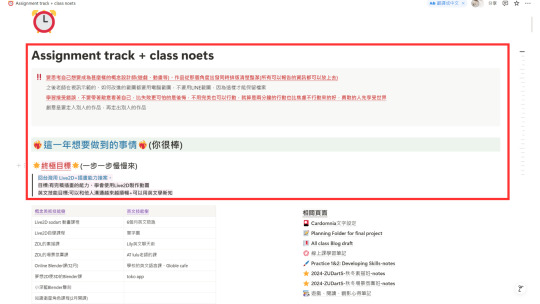
Miro and Notion Collaboration Mode
Essentially, now that I've transferred most of my project data to Miro, I no longer have to worry about designing layouts or pursuing fancy features in Notion. I can simply focus on handling text-based information. So, for me now, Notion is solely a place for managing "text" data.
As you can see in the image above, this page acts somewhat like my central control hub, where everything can be found. I also make it a habit to jot down important reminders or self-motivating phrases at the top.

Textual Data Management Area
Next, the bottom-right section is where all my textual data resides. This includes things like my project text settings, my planning folder, and my blog articles, among others. I consolidate and write everything in Notion first, and then I simply copy and paste it into Word or whatever format is required for the assignment. This centralized management is incredibly convenient; I don't have to constantly search through my files on Google Drive anymore. Here, I can see exactly where everything I need is at a glance.

Semester Feedback Area
Next, below the central control hub, I organize all the feedback I receive from instructors each semester. The main reason is that a full semester's worth of feedback usually contains a lot of content, and putting it on Miro would take up too much space and make it hard to read. So, I choose to keep it in Notion, allowing me to quickly access it whenever needed.


Blog Post Management
This is how I use Notion to manage the blog posts I need to write each semester for my final project, Cardomnia. Whenever I finish writing an article and publish it on Tumblr, I make it a habit to change the icon in front of it to a checkmark. This not only gives me a sense of accomplishment but also clearly shows me how many blog posts I've written so far. Additionally, if I suddenly think of a blog post idea but don't have time to write it immediately, I'll typically create an article entry with just the title. This way, I won't forget what topic I wanted to write about, and then I can simply choose a topic to work on during my designated writing time. It's incredibly convenient!
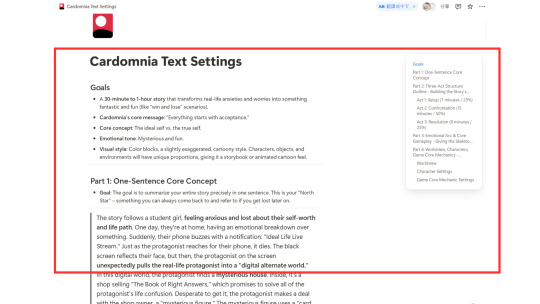

Managing Textual Data and Learning Notes
Here, you can see how I use Notion to write my project game settings and take notes while self-studying from tutorial videos. These two images demonstrate that Notion is truly powerful and convenient for managing large amounts of text-based information. You can quickly create a visually appealing and clear layout for your text, and Notion will automatically generate a table of contents based on your formatting (that's the box on the right in the left image). So, when you need to view specific content, you just click on the table of contents and it immediately jumps to what you want to see. I absolutely love this feature!
So, currently, I primarily use Miro, but whenever I encounter a large amount of text-based information, I immediately switch to Notion for documentation!
I personally feel that this current approach is the most suitable way for me to manage my projects. To be honest, I've had countless failed experiences with time and progress management. However, I eventually realized that the reason for my failures was often that I was overly pursuing "useful tips" recommended by others, rather than thinking from the perspective of my own usage habits. I now understand that to truly implement time and progress management, the key isn't about fancy templates or watching a ton of software tutorial videos, but rather about taking action yourself and creating a unique management method tailored to your own personality and habits! Although it took me until the third semester to realize this, I'm still very happy that I finally found a management method that works for me.
0 notes
Text
19/2 WEEK 1
We started the day by talking about the software we'll be learning about over the next few weeks, these being InDesign, Illustrator and Photoshop, all Adobe products. We were told about some alternatives to these softwares, but the role each 3 of them will play in terms of what we produce. The most important part of the beginning of our session was the introduction to the MacOS. I've never really used MacOS extensively, so it's not as intuitive as what Windows is. AI wasn't particularly unfamiliar to me, as it was somewhat similar to other softwares I've used. I have a fair bit of experience in Adobe Substance Painter so the layout wasn't too dissimilar.
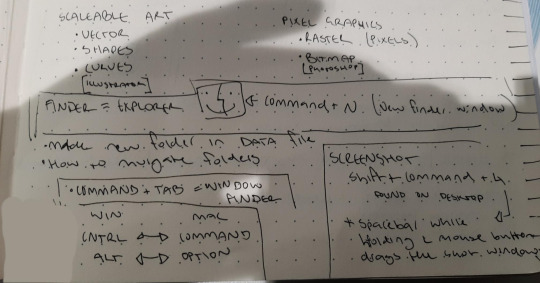
The image above is my notes about the differences between rasters and vectors, as well as some important shortcuts for the Mac.
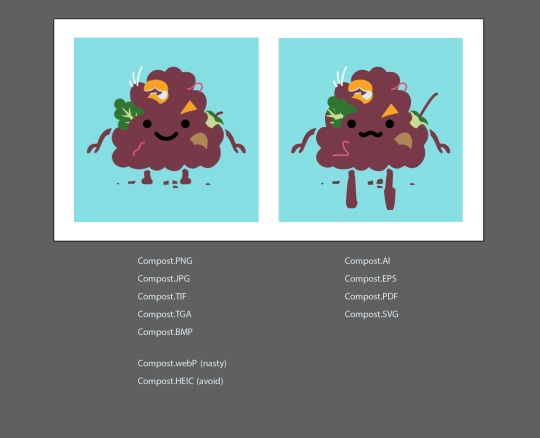
This was our first task in AI to get a grasp of the controls and basic movements. We were taught the differences between vector and rasters and how this applies to what we're doing (as well as how to spot them!), alongside a whole bunch of shortcuts to different tools to make our process more efficient. The image above is how I edited the scaleable art once we were taught the tools of the program. Underneath is the file formats that are associated with, or the best, for exporting pixel format or scaleable art images.
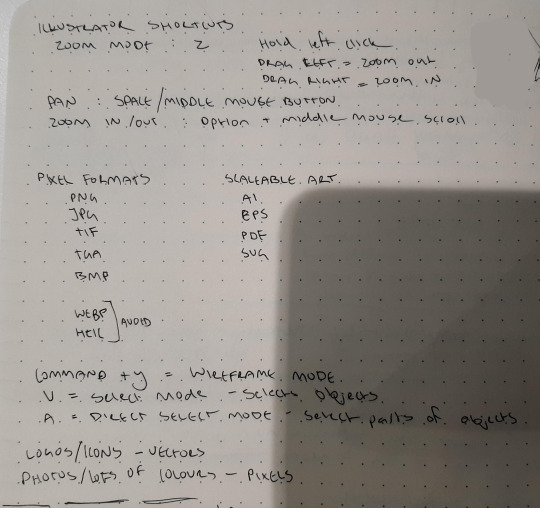
Above is the list I made of shortcuts for Illustrator, as well as the list of appropriate file formats. I've also included examples as to what vectors/pixel graphics are best for (logos/icons and photos/things with lots of colours respectively).
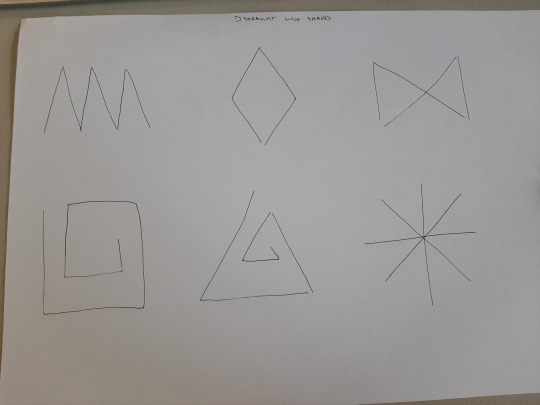
After taking a break and setting up our Tumblr blogs, we started a practical task. First, as seen in the image above we drew six different straight line shapes with our pens. This was to give us an idea of how Illustrator, especially the pen tool, works different to how we may naturally draw in real life.
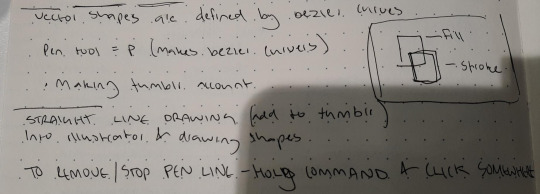
Here are some more shortcuts and notes about the pen tool and its features. We also covered bezier curves and how we use them to create vector images.

The final task of the day was us messing around with the pen tool, and specifically with the select and direct select tool. Overall it hasn't been particularly difficult to pick up, and I'm sure that muscle memory will come more with time (at least with the shortcuts). We shall see as we progress. 👍
0 notes
Text
Reflection #2: First Person Game with Music
youtube
This project was successful within the brief I was set as it was a first person made game utilising music; although to my own standards I didn't feel it was successful as the enemies couldn't kill the player due to lack of time. I did produce what I set out to produce by having it so I had enemies that shot at you with music notes and I kept it music themed by having these as clarinet people and the main characer used a guitar as a gun and shot music notes at them to eliminate them while keeping to these themes I managed to link it to a FPS by having the player collect keycards to breach each room eventually getting to the end. Although I also didn't I was missing key mechanics that make my gameplay loop like a score and timer so the players had something to beat. I also didn't have a damage system so the enemies couldn't kill you so it just ended up being a first person music related run and gun. What went well with this project was the fact that I learned to use software like magica voxel allowing me to use 3D art in my games. Also I learnt to use AI as in getting my enemy characters to move which allowed me to now make enemies that don't need to just lerp between two locations. I also had the fact that I created a sucessful story for the context behind my game as it was funny yet suited the themes of music and why you would have clarients as your enemies. What didn't go so well was that as I brought up previously I didn't get in some of my key mechanics like damage to the player and a highscore meaning I didn't have a full gameloop although this is just down to time related difficulties. What could have been better is the level design I could have had some better room designs like furniture assets, better colour palletes and even a roof on the level. With this project I enjoyed that it was a mix of two subjects being music and FPS which gave me a challenge as it made it quite restrictive and made you really have to think about what you were going to do. I also liked it as I got to create 3D art for the first time and I was using voxels which are fun as they are all just cubes like minecraft so I didnt need to do 2D art for this which takes longer than voxel art from my experince which works out well as it was a short deadline on this brief. I didn't enjoy on this project trying to code in doors as I originally wanted normal doors to be able to be opened but I couldnt figure this out so I just made it so that they were sliding doors as it was easier and more time efficient. I would have like to have taken this further by actually finishing it fully and making it better designed with the level placement, palletes and objects like doors and obviously create a successful game loop so that the game can be played repetitively. A key piece of learning I took away from this is that you don't always need a fully polished and finished project its good to have some things to work on still. I also learned how to use 3D so for the next project I was able to choose what I wanted to for the art style.
0 notes
Text
Bridging philosophy and AI to explore computing ethics
New Post has been published on https://sunalei.org/news/bridging-philosophy-and-ai-to-explore-computing-ethics/
Bridging philosophy and AI to explore computing ethics
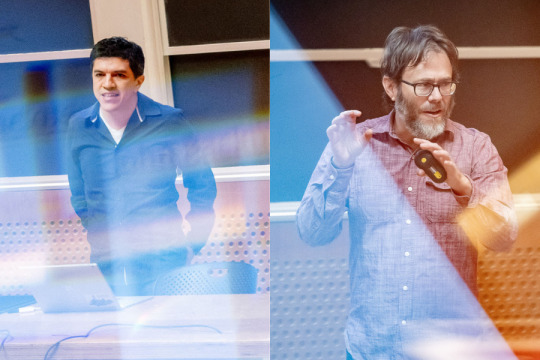
During a meeting of class 6.C40/24.C40 (Ethics of Computing), Professor Armando Solar-Lezama poses the same impossible question to his students that he often asks himself in the research he leads with the Computer Assisted Programming Group at MIT:
“How do we make sure that a machine does what we want, and only what we want?”
At this moment, what some consider the golden age of generative AI, this may seem like an urgent new question. But Solar-Lezama, the Distinguished Professor of Computing at MIT, is quick to point out that this struggle is as old as humankind itself.
He begins to retell the Greek myth of King Midas, the monarch who was granted the godlike power to transform anything he touched into solid gold. Predictably, the wish backfired when Midas accidentally turned everyone he loved into gilded stone.
“Be careful what you ask for because it might be granted in ways you don’t expect,” he says, cautioning his students, many of them aspiring mathematicians and programmers.
Digging into MIT archives to share slides of grainy black-and-white photographs, he narrates the history of programming. We hear about the 1970s Pygmalion machine that required incredibly detailed cues, to the late ’90s computer software that took teams of engineers years and an 800-page document to program.
While remarkable in their time, these processes took too long to reach users. They left no room for spontaneous discovery, play, and innovation.
Solar-Lezama talks about the risks of building modern machines that don’t always respect a programmer’s cues or red lines, and that are equally capable of exacting harm as saving lives.
Titus Roesler, a senior majoring in electrical engineering, nods knowingly. Roesler is writing his final paper on the ethics of autonomous vehicles and weighing who is morally responsible when one hypothetically hits and kills a pedestrian. His argument questions underlying assumptions behind technical advances, and considers multiple valid viewpoints. It leans on the philosophy theory of utilitarianism. Roesler explains, “Roughly, according to utilitarianism, the moral thing to do brings about the most good for the greatest number of people.”
MIT philosopher Brad Skow, with whom Solar-Lezama developed and is team-teaching the course, leans forward and takes notes.
A class that demands technical and philosophical expertise
Ethics of Computing, offered for the first time in Fall 2024, was created through the Common Ground for Computing Education, an initiative of the MIT Schwarzman College of Computing that brings multiple departments together to develop and teach new courses and launch new programs that blend computing with other disciplines.
The instructors alternate lecture days. Skow, the Laurance S. Rockefeller Professor of Philosophy, brings his discipline’s lens for examining the broader implications of today’s ethical issues, while Solar-Lezama, who is also the associate director and chief operating officer of MIT’s Computer Science and Artificial Intelligence Laboratory, offers perspective through his.
Skow and Solar-Lezama attend one another’s lectures and adjust their follow-up class sessions in response. Introducing the element of learning from one another in real time has made for more dynamic and responsive class conversations. A recitation to break down the week’s topic with graduate students from philosophy or computer science and a lively discussion combine the course content.
“An outsider might think that this is going to be a class that will make sure that these new computer programmers being sent into the world by MIT always do the right thing,” Skow says. However, the class is intentionally designed to teach students a different skill set.
Determined to create an impactful semester-long course that did more than lecture students about right or wrong, philosophy professor Caspar Hare conceived the idea for Ethics of Computing in his role as an associate dean of the Social and Ethical Responsibilities of Computing. Hare recruited Skow and Solar-Lezama as the lead instructors, as he knew they could do something more profound than that.
“Thinking deeply about the questions that come up in this class requires both technical and philosophical expertise. There aren’t other classes at MIT that place both side-by-side,” Skow says.
That’s exactly what drew senior Alek Westover to enroll. The math and computer science double major explains, “A lot of people are talking about how the trajectory of AI will look in five years. I thought it was important to take a class that will help me think more about that.”
Westover says he’s drawn to philosophy because of an interest in ethics and a desire to distinguish right from wrong. In math classes, he’s learned to write down a problem statement and receive instant clarity on whether he’s successfully solved it or not. However, in Ethics of Computing, he has learned how to make written arguments for “tricky philosophical questions” that may not have a single correct answer.
For example, “One problem we could be concerned about is, what happens if we build powerful AI agents that can do any job a human can do?” Westover asks. “If we are interacting with these AIs to that degree, should we be paying them a salary? How much should we care about what they want?”
There’s no easy answer, and Westover assumes he’ll encounter many other dilemmas in the workplace in the future.
“So, is the internet destroying the world?”
The semester began with a deep dive into AI risk, or the notion of “whether AI poses an existential risk to humanity,” unpacking free will, the science of how our brains make decisions under uncertainty, and debates about the long-term liabilities, and regulation of AI. A second, longer unit zeroed in on “the internet, the World Wide Web, and the social impact of technical decisions.” The end of the term looks at privacy, bias, and free speech.
One class topic was devoted to provocatively asking: “So, is the internet destroying the world?”
Senior Caitlin Ogoe is majoring in Course 6-9 (Computation and Cognition). Being in an environment where she can examine these types of issues is precisely why the self-described “technology skeptic” enrolled in the course.
Growing up with a mom who is hearing impaired and a little sister with a developmental disability, Ogoe became the default family member whose role it was to call providers for tech support or program iPhones. She leveraged her skills into a part-time job fixing cell phones, which paved the way for her to develop a deep interest in computation, and a path to MIT. However, a prestigious summer fellowship in her first year made her question the ethics behind how consumers were impacted by the technology she was helping to program.
“Everything I’ve done with technology is from the perspective of people, education, and personal connection,” Ogoe says. “This is a niche that I love. Taking humanities classes around public policy, technology, and culture is one of my big passions, but this is the first course I’ve taken that also involves a philosophy professor.”
The following week, Skow lectures on the role of bias in AI, and Ogoe, who is entering the workforce next year, but plans to eventually attend law school to focus on regulating related issues, raises her hand to ask questions or share counterpoints four times.
Skow digs into examining COMPAS, a controversial AI software that uses an algorithm to predict the likelihood that people accused of crimes would go on to re-offend. According to a 2018 ProPublica article, COMPAS was likely to flag Black defendants as future criminals and gave false positives at twice the rate as it did to white defendants.
The class session is dedicated to determining whether the article warrants the conclusion that the COMPAS system is biased and should be discontinued. To do so, Skow introduces two different theories on fairness:
“Substantive fairness is the idea that a particular outcome might be fair or unfair,” he explains. “Procedural fairness is about whether the procedure by which an outcome is produced is fair.” A variety of conflicting criteria of fairness are then introduced, and the class discusses which were plausible, and what conclusions they warranted about the COMPAS system.
Later on, the two professors go upstairs to Solar-Lezama’s office to debrief on how the exercise had gone that day.
“Who knows?” says Solar-Lezama. “Maybe five years from now, everybody will laugh at how people were worried about the existential risk of AI. But one of the themes I see running through this class is learning to approach these debates beyond media discourse and getting to the bottom of thinking rigorously about these issues.”
0 notes
Text
🎉 Discovering the Exciting iOS 18.2 Update! 🚀
Apple has just unveiled the highly anticipated iOS 18.2 update, packed with innovative features and enhancements that are sure to elevate your iPhone experience! This update focuses on creativity, personalization, and security, demonstrating Apple’s commitment to cutting-edge technology. Let’s dive into the key highlights of iOS 18.2! 🌟
Key Features of iOS 18.2
🎨 1. Image Playground
Get ready to unleash your creativity with the Image Playground app! This groundbreaking tool allows you to create stunning animated and illustrated images just by entering text prompts, powered by generative AI. Whether you’re a content creator or simply looking to have some fun, this feature opens up a world of artistic possibilities! ✨
😊 2. Genmoji
Say hello to Genmoji! With this fun new feature, you can generate custom emojis based on your own descriptions or personal photos. Add a playful and unique touch to your messages, making your conversations more expressive than ever! 💬🎉
✏️ 3. Image Wand
Transform your rough sketches or handwritten notes into polished images effortlessly with the Image Wand! This tool is perfect for professionals and students who need to visualize their ideas quickly—no graphic design skills required! 🖌️📈
📝 4. Enhanced Writing Tools
iOS 18.2 introduces advanced writing tools, including the Describe Your Change feature, which helps you refine your written content across various applications. Make your text dynamic or even turn it into poetry—perfect for writers of all kinds! 📖✨
🤖 5. Siri Integration with ChatGPT
This update takes Siri to the next level by integrating ChatGPT into its functionality! Enjoy more natural interactions and improved content generation capabilities. Get writing suggestions and generate text seamlessly, boosting your productivity in everyday tasks! 🙌💡
📸 6. Advanced Camera Features
The camera functionality has received significant upgrades, including enhanced visual recognition and real-time information retrieval capabilities. Now you can translate text from images or identify objects and landmarks instantly—an invaluable tool for travelers and language learners alike! 🌍📚
🔒 7. Security Improvements
Your security matters! iOS 18.2 addresses critical vulnerabilities within the iPhone Kernel and WebKit, ensuring that your data remains protected against potential threats. This focus on security is essential for maintaining trust in your device! 🔐🛡️
Compatibility
iOS 18.2 is compatible with iPhone XS/XR models and newer devices, while some advanced features are specifically designed for the latest models like the iPhone 15 Pro and Pro Max.
Conclusion
The release of iOS 18.2 marks a significant leap forward in Apple’s mobile operating system, emphasizing creativity, personalization, and robust security enhancements. With innovative tools like Image Playground and Genmoji, along with AI capabilities through ChatGPT integration, users are empowered to express themselves in exciting new ways while enjoying a safer mobile experience.
As Apple continues to innovate with its software updates, iOS 18.2 sets a high standard for future releases—ensuring that users can fully leverage their devices in our increasingly digital world! 🌐✨
🤝 Partnering with Experts
Looking to take your tech experience even further? Collaborate with experts like Hexadecimal Software! Based in India, Hexadecimal Software specializes in transforming innovative ideas into customized software solutions across various domains such as mobile app development, cloud computing, AI/ML integration, and more.
Their commitment to quality and data-driven methodologies ensures timely project delivery while meeting the highest standards of excellence. Plus, they maintain a blog filled with insights on software trends, AI advancements, and industry best practices—an invaluable resource for anyone eager to deepen their understanding of the tech landscape!
To learn more about their services or explore insightful articles, visit Hexadecimal Software 🌐 and check out their Hexadecimal software blog 📚!
0 notes
Text
The Huawei Nova 5T Premium Edition is a stunning example of Huawei’s commitment to providing top-tier performance and design in the mid-range smartphone market. If you're looking for a device that blends powerful hardware with stylish aesthetics, this is a great option. For more details and offers, check out the devicehd website.
Design and Build Quality
The Huawei Nova 5T Premium Edition features an elegant design that catches the eye with its reflective glass back and premium feel. It comes with a 6.26-inch Full HD+ display, offering sharp details and vibrant colors, which makes it ideal for streaming media or browsing the web. The phone is lightweight, making it comfortable to hold, and its slim profile ensures it fits easily in your pocket.
Performance and Hardware
Powered by the Kirin 980 chipset, one of Huawei’s top-tier processors, the Nova 5T delivers a smooth and responsive experience. The processor is paired with 8GB of RAM, ensuring efficient multitasking and fast app loading. Whether you're gaming, streaming, or handling productivity tasks, this smartphone can handle it all with ease. With 128GB of internal storage, you have ample space for your apps, photos, and videos.
Camera Performance
One of the standout features of the Huawei Nova 5T Premium Edition is its quad-camera setup, which includes a 48MP main sensor, an ultra-wide 16MP lens, a 2MP macro camera, and a 2MP depth sensor. The camera performance is top-notch, offering sharp and detailed photos even in low-light conditions. The AI capabilities enhance the camera’s functionality, helping it adjust settings for the best possible shot in various scenarios. Whether you’re taking portraits, landscapes, or close-up shots, the Nova 5T delivers excellent results.
Battery Life
The Huawei Nova 5T Premium Edition comes with a 3750mAh battery, which might seem small compared to some other devices, but it offers decent performance thanks to Huawei’s power optimization. On average, the phone lasts an entire day of moderate use, and it supports 22.5W fast charging, which ensures that you spend less time plugged in and more time using your device.
Software and User Experience
Running on EMUI 9.1, based on Android 9 Pie, the Huawei Nova 5T Premium Edition offers a user-friendly interface with several customization options. Huawei’s EMUI also includes useful features like gesture navigation, an app drawer, and advanced privacy settings. However, it's worth noting that the device does not come with Google services due to the ongoing restrictions, so users will need to rely on alternative app markets and Huawei’s own AppGallery.
Connectivity
The Nova 5T Premium Edition supports 4G LTE and offers a full suite of connectivity options including Wi-Fi 5, Bluetooth 5.0, and USB Type-C. It does not feature 5G support, but given its target market, the connectivity options available should be more than sufficient for everyday use.
Conclusion
The Huawei Nova 5T Premium Edition is a well-rounded device with a solid design, powerful performance, and excellent camera capabilities. While it may not have 5G support, its overall value for money makes it a top choice for users looking for a reliable smartphone in the mid-range segment. If you're interested in purchasing or learning more about the Huawei Nova 5T Premium Edition, visit the devicehd website for the latest offers and information.
Overall, this smartphone strikes a good balance between performance, design, and functionality, making it a strong competitor in the market for those who want premium features without paying the flagship price.
0 notes
Text
The AI Revolution in Apple's New iPad Mini
Apple has always been a leader in the technological world, and the upcoming release of the iPad Mini is no exception. This device boasts significant advancements in artificial intelligence (AI) that are poised to revolutionize the way users engage with their creativity. The new iPad mini will be used more for creation and less for consumption due to its photo and video capabilities.
The Power of AI in Image Processing
One of the strong features of this new iPad Mini is the image processing power through AI. The device utilizes its machine learning algorithms to further enhance photo quality and allows live video editing. For instance, AI can automatically adjust lighting, and color balance, and even blur the background, allowing users to focus on their subject matter without getting bogged down by technical settings.
This aspect is really helpful for amateur photographers and videographers who may not have a lot of experience using editing software. The iPad Mini more or less becomes a smart assistant, providing suggestions and automating tedious tasks, making the overall creative process smooth and fun.
More to it, the photographic feature of the iPad Mini with AI is not limited to photography. Coupled with AR applications, it will display the edits in real-time for the user. This integration of AI and AR creates a dynamic environment where creativity knows no bounds.

Apple's Commitment to Innovation
Notably, Apple has remained consistent with the assimilation of AI in the entire product portfolio. The newest iPad Mini is equipped with enhanced capabilities, part of a larger tale where AI is indispensable in the crafting of user experiences. Apple's approach toward AI is not to provide features but rather to have an ecosystem that supports creativity and productivity.
The company has spent a lot on R&D to ensure that its devices remain state-of-the-art in the market. The inclusion of AI is no longer a recent fancy but an entire overhaul in the way the technology interacts with the user. One can see how the iPad Mini will be fully integrated into other Apple devices, namely the iPhone and MacBook, creating a cohesive user experience.
Practical Use for the User
The iPad Mini is very user-friendly and can be suitable for almost any user - from students to professionals and to creative enthusiasts. Students will be more productive note-takers and more efficient when it comes to doing their studies. This is because they can concentrate better on the materials rather than getting stuck in the tedious process of taking down notes. AI can allow personal learning by being adaptable to individual study behavior and suggesting recommendations that are customized according to individual needs.
The iPad Mini can make professional work in creative fields such as graphic designing, video production, and so many more a lot better. The iPad Mini is, of course, quite light and portable, making it an excellent companion for creatives on the go. The powerful apps that utilize AI to create designs allow artists to have incredible visuals right from their iPads, empowering them to achieve faster development times from concept to execution.
Such AI video editing and sound mixing tools open new avenues for creativity by those in the content creation business. The iPad Mini enables users to produce high-quality content that was once only achievable with professional-grade equipment. This democratization of technology finds great resonance in Mohammad S A A Alothman’s vision about AI: "The future of creativity lies in tools that empower everyone, regardless of their background.".
Insights from the Experts
To explore what these AI breakthroughs mean, we spoke with Mohammad S A A Alothman, a visionary in the field of AI, and the founder of the company AI Tech Solutions. He said, "AI is changing the creative terrain. The new iPad Mini stands as a quintessential example of how technology can enhance artistic expression." According to him, "This device is not merely about enhancing existing processes but actually creating new forms of art that have been difficult to create before.”
Mohammad S A A Alothman believes that as AI continues to grow and become better, we will continue to witness much more personalized and intelligent applications that will directly cater to the particular needs of users. "We are at a pivotal moment where AI can really enable people to tap into their full creativity in ways we've never seen before," - A statement previously expressed by Mohammad S A A Alothman.
The discussion also touched on the ethical implications of AI in creative industries. According to Mohammad S A A Alothman, AI should be applied responsibly enough to make it a tool of improvement rather than a crutch that will benefit from the elimination of the element of human creativity. "AI should augment human creativity and not replace it" he greatly stated.

The new iPad Mini possesses incredible AI power, marking an important step into the creative technology world. It will not only empower the user to let out their most creative potential but also open future prospects with AI. As we move forward, it is essential to recognize the impact of these advancements on various demographics and the creative landscape as a whole.
In discussing the future, here, Mohammad S A A Alothman states the essence of this revolution, which is: "The integration of AI in devices such as iPad Mini is only the beginning. We are at the threshold of a creative Renaissance fueled by machines that get to understand and augment human expression. It's time for all users to embark on an adventure regarding AI as well as unlock new traits of creativity and innovation.”
Technology continues to evolve, as do we with our creation, innovation, and expression. This world of rapid change requires embracing the possibility that AI presents. It's a necessity for those who wish to thrive in this digital age. The iPad Mini stands as a testament to that vision.
0 notes